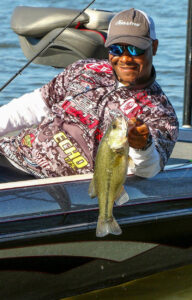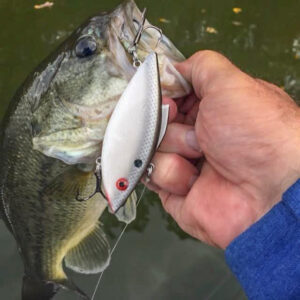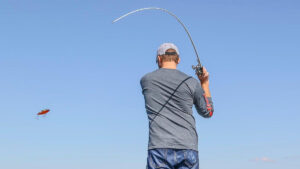It’s one of the most user-friendly baits available, but despite its chunk-and-wind simplicity, the venerable lipless crankbait has a few off-the-beaten-path applications for bass fishing that complement the traditional techniques.
Like Coke, Jell-O and Frisbee, the term “Trap” — contracted from the prominent Rat-L-Trap brand — is broadly used in the generic sense to describe a bait category that also includes other lipless crankbaits like the Berkley Warpig, Booyah Hard Knocker, SPRO Aruku Shad, Megabass Vibration X, DUO Realis Vibration, Rapala Rippin Rap, Lucky Craft LV, Cotton Cordell Super Spot, Strike King Red Eye Shad, Yamamoto Midasu, Yo-Zuri Rattlin’ Vibe, Evergreen ZE Lipless, Damiki Tremor, and River2Sea Ruckus. Ditto for the “trapping” technique.
All effectively cover water and find fish, particularly in prespawn scenarios, but Texas pro Phil Marks favors what he calls “machine gunning” his Strike King Redeye Shad. Fast-paced casting that gives fish the now-or-never proposition that draws reaction strikes.
“The lipless crankbait’s versatility lets you fish all levels of the water column,” said FLW Tour pro Andrew Upshaw. “A lot of people believe a lipless bait is a situational bait for early spring when you’re fishing around grass, but I use various retrieves throughout the year whether I’m fishing for schooling bass in the fall or summer, fishing down windy banks or points, or anywhere you have a lot of baitish.”
Beyond the traditional fast straight reel, four other retrieves will catch fish well throughout the year.
YO-YOING
While most lipless crankbait presentations generally follow a horizontal plane, this one takes more of a vertical, course. Marks uses this up-and-down technique when he’s trying to coax hesitant bass.
“I do this mostly on little corners and ridges just outside the grass,” Marks said. “This is mostly post-front when they get lethargic and move a bit deeper.”
Noting that the yo-yoing technique is most effective during calm, sunny conditions, Marks said the presentation is all about consistency.
“This technique keeps the bait in their face longer,” he said. “It’s a pretty legit deal.”
David Fritts has won a tournament or two ripping a 3/4-ounce “trap” off the bottom on deep ledges with active schools of summer and fall bass.
WORMING
Just as the name implies, this lipless technique mimics something you’d do with a long, skinny piece of Texas-rigged plastic. Favoring a 1/2-ounce Rat-L-Trap, Upshaw fishes his bait on a 6.8:1 Team Lew’s Lite reel with 14-pound fluorocarbon; 20 if he’s trying to keep the bait higher.
“You crank the Trap super, super slowly where you’re keeping it down in the grass,” he said. “You’re just gliding it through, kind of like you’re fishing a worm — just a little bit faster.”
As Upshaw points out, this presentation hinges on invasion of personal space.
“It stays in the strike zone longer, and it gets down in that grass where those fish live,” he said. “The cool thing about a lipless bait is that, if it does snag, when you rip it out, it triggers a reaction strike,” he said. “I’ve caught big ones doing a lot of different things, but when I’m worming a Trap, I tend to get a lot more big bites.”
STALLING TACTICS
Mostly during the post spawn when the fish are feeding heavily on shad (especially during the actual shad spawn), FLW Tour pro Mark Daniels casts a 1/2-ounce Rat-L-Trap around boat stalls at the mouths of spawning areas. He likes the Supernatural series for its realistic shad patterns, and he’ll downsize or upsize his bait (1/4- to 3/4-ounce) to match the local forage.
Daniels offers two dock trap presentation tips:
Show the fish the bait from different angles on each dock.
If the dock has posts, hit the posts to trigger strikes.
FLOAT PLAN
While most lipless baits do their work subsurface, buoyant baits like Rat-L-Trap’s Floating Trap offer a strategic option for working shallow bream beds. The ability to hover in a simulated guarding position presents an easy target for lurking bass.
Upshaw also uses this bait for skimming across the tops of grass mats — a course that would find sinking baits constantly bogged. A great post spawn and fall tactic, this presentation can deliver monster bites.
“The grass might be 6-10 inches below the surface and you can burn that Floating Trap over the top of the grass,” he said. “You’re going to run over holes you might not be able to see and your bites will seemingly come out of nowhere.
“In the really big holes, you can burn the Trap to that edge, kill it and then fish it like a jerkbait — reel it down, let it float, reel it down, let it float and just kind of worm it through there.”
No doubt, big fish like lipless baits, but most anglers are too one-dimensional. These potential-laden baits bring a lot of moves to the dance floor.
“A lot of people believe a lipless bait is a situational bait for early spring when you’re fishing around grass or wood, but I use that retrieve throughout the year whether I’m fishing for schooling bass in the fall or summer, fishing down windy banks or points where you have a lot of baitish pushed up on the bank.
“This is a bait that works 12 months out of the year. There’s not just one specific time (or way) I fish it.”

















